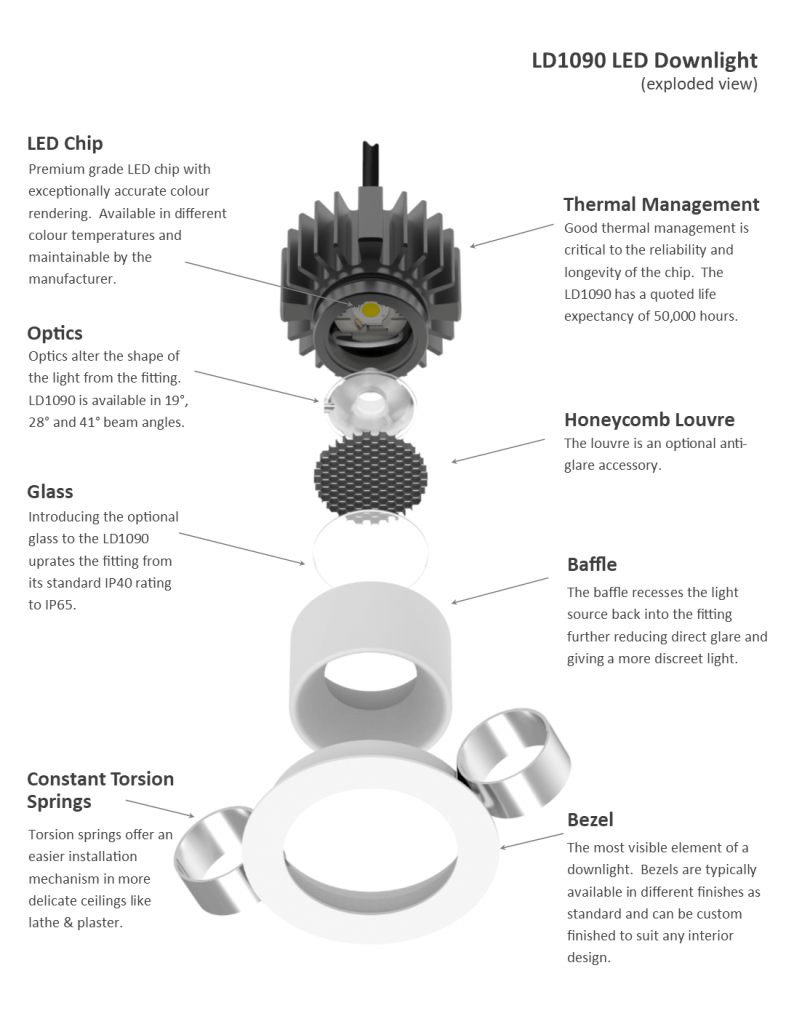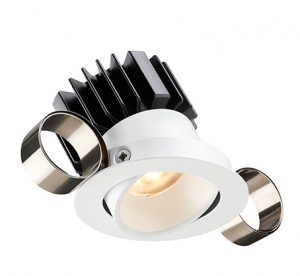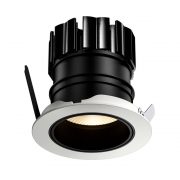LED lighting and lighting design
This post updated in June 2020 explores the relationship of LED lighting and lighting design in a bit more detail. We talk a lot about the characteristics of LED lights: colour temperature, colour rendering, beam width, light output etc. We rarely talk about what makes up the LED light fittings themselves. One of our most important suppliers recently released a new range of LED downlights. Included in the launch documentation was an exploded diagram of the elements that make up an LED light fitting. So that’s the inspiration for this post. What goes into an LED light fitting? Why is understanding the characteristics of LED lighting so important in lighting design?
Bear in mind that the LD1090 is just one of many that we use; it’s not one of our mainstream downlighting products. It’s a specialist downlight having been engineered for very high levels of light relative to its physical depth. However, it has all the main elements we need to talk about and the diagram hopefully makes each element of the fitting clear.

The light engine is the core of the fitting
Let’s start with the chip. This is the fundamental difference between the LED fittings in use today and incandescent sources like halogen that they have replaced. The chip is integral to the fitting. It delivers the light but unlike a lamp (light bulb), it’s not a user replaceable item that you can pick up at the shops. If your only exposure to LED lighting has been replacing a lamp in an old fitting with a replacement LED lamp that might come as a shock. Actually, it’s one of the core strengths of high quality dedicated LED fittings. It’s the combination of the high quality chip and thermal management that offers such great performance & reliability in such a small unit. Integrated LED chip with carefully designed thermal management offer great performance, reliability and longevity. The LD1090, like most of the fittings we use, has a quoted life expectancy of 50,000 hours.
All chips are not created equal. The very best light engines offer a better quality of light as well as superior reliability. Colour Rendering Index (CRI) is one measure of that quality. CRI is a measure of how accurately a given fitting renders colour. It’s not a perfect measure but fittings with 90+ CRI will provide a richer experience. The more accurate the colour rendering, typically the better the result.

We can specify the LD1090 with four colour temperatures. Typically we’d specify the warmer 2700K or 3000K rather than 4000K or 5000K. We can also choose to drive the fitting harder or less which means higher or lower levels of light. Driving this fitting at 350mA means 7W of power and 496 lumens; driving it at 700mA means 14W and 901 lumens. That level of performance is considerably higher than can be achieved with retrofit LED lamps.
Options alter the characteristics of the light output
We can specify different optics to select particular beam widths. This fitting has three beam width options (more for others). LD1090 can give 19°,28° or 41° beams of light. Adding accessories further changes the characteristics of the fitting. As standard the LD1090 is rated at IP40 but it can be specified at IP65.

We look for fittings that minimise glare. This particular downlight as standard features a baffle which sets the light source deeper into the fitting. If we need to reduce glare further here we can specify a honeycomb louvre.
Options alter the look of the fitting as well as the performance. LD1090 is available as standard in White (RAL 9016) and a black but can be specified in any other RAL colour as a special order. Other fittings might also offer metal finish bezels or different finishes for the baffle. All of which adds another level of flexibility (and complexity).
Finally there is the question of how the fitting is controlled. We can specify five different control gear options. The fitting can be switched (non dimming) or dimmed using mains dimmable, 0-10v, DMX or DALI drivers.
LED lighting and lighting design
Conservatively speaking that range of options means the LD1090 is available in over 2,000 configurations. It’s many more times that if you take all the different finishes into consideration. Other models can run into hundreds of thousands of possible configurations. If lighting design is about specifying the right fitting in the right location with the right control, having hundreds of thousands of options makes things more complicated.
Understanding LED lighting and lighting design together is critical to the success of any lighting scheme. Once you understand what the fittings can do and what the different elements contribute you can match specific fittings to the challenge you’re facing. Break the design issue into simpler design questions. What are you lighting and how does it behave when you shine light on it? How much light do you need? Do you need a narrow spot or a wide spread of light? Does the fitting need to have a higher degree of ingress protection (IP). Do you need to dim the fitting and if so, how? All of a sudden that complexity in the fitting becomes a handy checklist where you can match what the fitting does with what the situation demands.
We spend a lot of time looking at new LED fittings and testing them against the best fittings we currently use. Figures can tell you a lot about a fitting but nothing beats actually testing them. Shining a light source against what it’s going to be lighting, whether that’s a bookmarked granite sample or a strawberry tart, is very revealing. When you talk to a lighting designer, make sure you give them as full a brief as possible and ask to see how the scheme is going to work. Above all, see the lights working so you can get familiar with them and the effect they give.


